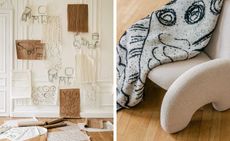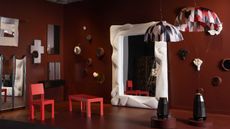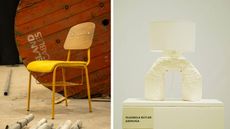Mathieu Lehanneur considers the world's plurality at Milan’s Triennale
In a new exhibition curated by Maria Cristina Didero, French multidisciplinary designer Mathieu Lehanneur explores human life and the environment (on view until 12 June 2022)

Considering what the French multidisciplinary designer calls ‘the state of the present world’, Mathieu Lehanneur unveils ‘The Inventory of Life’ at the Triennale Milano, a new personal exhibition curated by Maria Cristina Didero and coinciding with Milan Design Week 2022. Themes include the fragility and transiency of human life – from the effect of depression to the interconnected damage experienced by changes in the environment.
Mathieu Lehanneur at Triennale: The Inventory of Life

Design, science, art, and anthropology are intertwined through four massive installations. ‘The projects that we are presenting are very close to people and to my idea of what design is for, in this world. My personal mantra is “design is about people and not about chairs”,’ Didero explains. ‘Not because chairs are unimportant, but because I’m interested in what happened before. Much of Matthieu’s work fits this concept, this attitude that I have when I approach a design exhibition.’
State of the World is a series of anodised aluminium sculptures that visually represent the evolution and history of the human population in over 150 countries, reflecting changing demographics, birth rate, life expectancy, and history. The enamelled ceramic round sculptures of 50 Seas recreate the subtle nuances of blue found in the world's seas and oceans.
A luminous glass filament suspended from the ceiling displays different yet equally alarming projections and forecasts of rising sea levels in How Deep is Time, while Live/Leave is a collection of white canvases with black holes, the diameter indicating the number of suicides in each country. ‘You can choose between seeing the hole, which represents all those who chose suicide, and seeing the white, which represents those who chose to live. To me, it's a way of making us consider our own decisions and positions in the world,’ says Lehanneur.

The title, The Inventory of Life, is intriguing for several reasons: ‘I’m the youngest in a large family with many brothers and sisters,’ Lehanneur explains. ‘Living in a large family means living in a large community, and you must negotiate your own desires, wishes, and goals with the common interests of your family and community. What I experienced in my family is what everyone on this planet lives; we all have to negotiate between who we are and what the rest of the world is.’
According to Lehanneur, the show provides no precise messages or answers, but rather examines the balance between the world and our personal perspective and sensibility. At the same time, each work is based on scientific and statistical data provided by reliable sources: from the United States to the World Health Organization, to satellite photographs commissioned for the project.
Lehanneur’s approach to design seems a path to improve the connection between data, planet, environment, and human beings. ‘It’s about trying to understand what the present means for humans, about the willingness to live, the state of the sea, and the ability to control the future,’ he says. ‘My hope is that people will take something away from this exhibition, and feel something. It's moving, when you realise it's not just about numbers, statistics, and information, but about other people.’
Wallpaper* Newsletter
Receive our daily digest of inspiration, escapism and design stories from around the world direct to your inbox.
INFORMATION
Inventory of Life is on view at Triennale until 12 June 2022
triennale.org
mathieulehanneur.fr
ADDRESS
Triennale
Viale Emilio Alemagna, 6
20121 Milano
Cristina Kiran Piotti is an Italian-Indian freelance journalist. After completing her studies in journalism in Milan, she pursued a master's degree in the economic relations between Italy and India at the Ca' Foscari Challenge School in Venice. She splits her time between Milan and Mumbai and, since 2008, she has concentrated her work mostly on design, current affairs, and culture stories, often drawing on her enduring passion for geopolitics. She writes for several publications in both English and Italian, and she is a consultant for communication firms and publishing houses.
-
 The new Ford Capri wants to tap a vein of Gen X nostalgia. Does it succeed?
The new Ford Capri wants to tap a vein of Gen X nostalgia. Does it succeed?We ask if the all-electric Ford Capri can capture the swagger of its much-loved but rather oafish predecessor
By Guy Bird Published
-
 Rug designer Sibylle de Tavernost’s homage to Fernand Léger
Rug designer Sibylle de Tavernost’s homage to Fernand LégerAbstract modern art, craft heritage and contemporary life fuse in Sibylle de Tavernost's new limited-edition rugs
By Harriet Thorpe Published
-
 Private gallery Stiftung Froehlich in Stuttgart stands out with an organic, cloud-shaped top
Private gallery Stiftung Froehlich in Stuttgart stands out with an organic, cloud-shaped topBlue-sky thinking elevates Stiftung Froehlich, a purpose-built gallery for the Froehlich Foundation’s art collection near Stuttgart by Gabriele Glöckler
By Hili Perlson Published
-
 Faye Toogood brings new life to Matisse’s legacy
Faye Toogood brings new life to Matisse’s legacyMilan Design Week 2023: tapped by Maison Matisse, the London-based designer has taken inspiration from the French master’s forms to create a collection of heirloom-worthy objects
By Sam Rogers Published
-
 Prada Frames 2023: Milan programme announced
Prada Frames 2023: Milan programme announcedProgramme announced for Prada Frames 2023 at Milan Design Week, the annual symposium curated by Formafantasma at Luigi Caccia Dominioni's Teatro Filodrammatici from 17 to 19 April
By Rosa Bertoli Last updated
-
 Alessi Occasional Objects: Virgil Abloh’s take on cutlery
Alessi Occasional Objects: Virgil Abloh’s take on cutleryBest Cross Pollination: Alessi's cutlery by the late designer Virgil Abloh, in collaboration with his London studio Alaska Alaska, is awarded at the Wallpaper* Design Awards 2023
By Rosa Bertoli Published
-
 Salone del Mobile 2023: highlights from Milan Design Week
Salone del Mobile 2023: highlights from Milan Design WeekIn pictures: our highlights from Milan Design Week, held during the 61st Salone del Mobile 2023 (18-23 April)
By Rosa Bertoli Last updated
-
 Design Miami 2022: highlights from the fair and around town
Design Miami 2022: highlights from the fair and around townDesign Miami 2022 (30 November – 4 December) aims at ‘rebooting the roots of our relationship with nature and collective structures, ecospheres, and urban contexts’
By Sujata Burman Last updated
-
 Salon Art + Design 2022: design highlights not to miss
Salon Art + Design 2022: design highlights not to missWallpaper* highlights from Salon Art + Design 2022, New York
By Tilly Macalister-Smith Last updated
-
 Design Week Lagos 2022 celebrates creativity and innovation in West Africa and beyond
Design Week Lagos 2022 celebrates creativity and innovation in West Africa and beyondCurated by founder Titi Ogufere, Design Week Lagos 2022 is based on a theme of ‘Beyond The Box’
By Ugonna-Ora Owoh Last updated
-
 Designart Tokyo transforms the city into a museum of creativity
Designart Tokyo transforms the city into a museum of creativityDesignart Tokyo presents global design highlights through a series of exhibitions involving global creative talent and traditional Japanese craft
By Danielle Demetriou Last updated